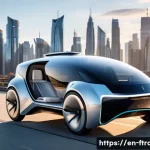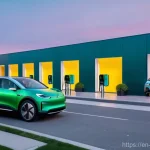Hey there, clean energy enthusiasts and eco-conscious drivers! If you’re anything like me, you’ve been watching the hydrogen vehicle space with a mix of excitement and a little bit of head-scratching.
We all love the idea of zero emissions, super-fast refueling, and a truly green drive, right? But then the big question pops up: where in the world do you even find a hydrogen fueling station?
It’s a real concern, and I’ve been there, staring at a map that looks a little sparse compared to what we’re used to with gasoline or even electric chargers.
Honestly, the journey for hydrogen cars has been a fascinating one, full of promising innovations and undeniable hurdles. While some experts are predicting a massive surge in hydrogen car adoption, with the market potentially hitting over $40 billion by 2033, we can’t ignore the current realities.
I mean, I’ve personally felt the frustration when you’re hyped about a cutting-edge fuel cell electric vehicle (FCEV) like the Toyota Mirai or Hyundai Nexo, only to realize the infrastructure isn’t quite keeping pace with the ambition.
We’re seeing some incredible developments, especially in places like California, which is leading the U.S. with the majority of stations, and a huge $1.2 billion federal investment recently approved for a hydrogen hub.
But even there, meeting targets has proven tricky, with Shell even closing some of its hydrogen network, which definitely makes you wonder. It’s clear we’re in a period of significant transition.
Governments worldwide, including the U.S. with its multi-million dollar grants for new fueling infrastructure, are pushing hard to make hydrogen a viable option, particularly for heavy-duty transport.
This isn’t just about passenger cars anymore; it’s about decarbonizing entire industries! But as much as I adore the vision, the current reality of limited stations, high costs, and logistical challenges around hydrogen storage and distribution can be a bit of a buzzkill for everyday drivers.
So, if you’re curious about where the hydrogen fueling landscape stands today, what’s on the horizon, and how this truly innovative technology is evolving, you’re in the right place.
Let’s dive into the specifics and get you the most up-to-date picture!
Mapping the Current Hydrogen Landscape: A Real-World View

California’s Pioneering Path and Global Efforts
Alright, let’s be real, when you first think about hydrogen fueling, your mind probably jumps straight to California, right? And for good reason! The Golden State has really been at the forefront, pushing the envelope with the most operational hydrogen fueling stations in the U.S. and some of the highest concentrations globally. I’ve personally seen how much effort has gone into building out this network, from the initial ambitious goals to the daily grind of keeping these stations running. It’s not just about putting a pump in the ground; it’s about the entire ecosystem – supply, distribution, maintenance, and user adoption. While they’ve certainly faced their fair share of bumps and delays, a few years ago, I remember mapping out a trip from San Diego up to San Francisco, and while it definitely required some planning, the stations were there. It’s a testament to the persistent work of companies like Shell (despite some recent changes) and True Zero, alongside state-level initiatives, that we have any infrastructure at all. Beyond California, places like Japan and South Korea have also made significant strides, often driven by strong governmental backing and a national commitment to hydrogen as a key energy vector. They’ve been investing heavily, aiming for widespread adoption of fuel cell electric vehicles and even hydrogen-powered trains and buses. Seeing these international examples gives me hope, because it shows that a robust hydrogen economy isn’t just a pipe dream; it’s something tangible being built, piece by painstaking piece, right now.
The Slow Burn of Expansion: Challenges and Triumphs
Now, let’s talk about the pace of expansion. If you’re like me, eagerly watching the news for every new station announcement, it can sometimes feel like a snail’s race, can’t it? The journey from a few scattered stations to a truly comprehensive network is anything but straightforward. I recall seeing headlines about how many stations were planned, only to find that construction or operational issues pushed deadlines back. It’s frustrating when you’re relying on this technology! For instance, meeting the initial targets set by various hydrogen consortia has proven tricky. But here’s the thing: behind the scenes, there’s incredible innovation happening. Companies are developing more efficient compressors, safer storage solutions, and smarter dispensing technology. The recent federal investment in hydrogen hubs across the U.S. is a monumental step, earmarking billions to kickstart regional ecosystems. This isn’t just about individual stations; it’s about building an entire supply chain, from production to delivery. It might not be as fast as we’d all like, but these are foundational changes that take time. Think of it like building the first highways; it seemed slow then too, but eventually, it transformed how we travel. I genuinely believe we’re in a similar foundational period for hydrogen, laying the groundwork for what will eventually be a much more expansive and reliable network.
Navigating the Hurdles: Why Widespread Access Isn’t Here (Yet)
The Chicken and Egg Conundrum of Infrastructure Development
This is probably the biggest head-scratcher for anyone looking at hydrogen vehicles: the classic chicken-and-egg situation. You want more hydrogen cars on the road, but people hesitate to buy them if there aren’t enough places to refuel. Conversely, station developers are reluctant to invest millions in new infrastructure without a guaranteed base of users. I’ve heard this argument countless times, and it’s a tough one to break. It feels like we’re perpetually stuck in the middle, waiting for one side to make the first big leap. When I was considering my first FCEV, this was my primary concern. I loved the idea, but the practicality of finding fuel was a significant deterrent. This situation isn’t unique to hydrogen; we saw similar challenges with early electric vehicle charging infrastructure, though the “home charging” option for EVs offered a temporary workaround. For hydrogen, fast refueling is a major perk, but it relies entirely on dedicated stations. Overcoming this requires coordinated efforts from governments, automakers, and energy companies to simultaneously grow both the vehicle fleet and the fueling network. It’s a massive undertaking, and honestly, sometimes it feels like we’re asking for a miracle, but progress is being made as the industry matures and more stakeholders commit to the vision.
Cost, Complexity, and the Supply Chain Saga
Let’s not sugarcoat it: building and operating a hydrogen fueling station is expensive. We’re talking millions of dollars for a single retail station, far more than a typical gas station or even a fast-charging EV hub. The equipment itself – the compressors, storage tanks, chillers, and dispensers – is highly specialized and needs to handle hydrogen at incredibly high pressures (up to 700 bar). Then there’s the cost of the hydrogen itself, which often needs to be transported from production facilities, sometimes over long distances. The logistical challenges are immense. I remember reading about a station that had to shut down temporarily because of an issue with its hydrogen supply line, leaving drivers stranded. It’s not just about the upfront capital; it’s the ongoing operational costs and the intricate supply chain that add layers of complexity. While “green hydrogen” produced from renewable energy is the ultimate goal, a significant portion of current hydrogen production still relies on natural gas, which has its own environmental footprint. This adds another layer of challenge as the industry strives for truly clean, sustainable production at scale. It’s a marathon, not a sprint, and every step, from production to pump, needs to be refined and cost-optimized for widespread adoption.
Government Green Lights and Industry Momentum: What’s Driving Expansion?
Massive Public Investment and Policy Support
Here’s where things get really interesting and, frankly, quite hopeful. Governments worldwide are finally stepping up with significant policy support and massive financial injections to kickstart the hydrogen economy. The U.S. Infrastructure Investment and Jobs Act, for example, allocated a whopping $9.5 billion specifically for clean hydrogen, including $8 billion for regional hydrogen hubs. I mean, that’s a game-changer! These aren’t just small grants; they’re multi-billion-dollar commitments designed to create entire hydrogen ecosystems, from production to end-use. We’re talking about developing infrastructure that can support not just passenger cars, but heavy-duty trucks, buses, and even industrial applications. I’ve followed the announcements of these hubs, and it’s clear the focus is on establishing robust, localized supply chains that can dramatically bring down costs and improve reliability. It feels like the tide is finally turning, with policymakers recognizing the strategic importance of hydrogen for decarbonization and energy independence. This kind of top-down support is absolutely crucial because, let’s face it, the private sector alone can’t shoulder the initial risks and costs of building an entirely new energy infrastructure. It’s exhilarating to see this level of commitment, making the hydrogen future feel less like a distant dream and more like an unfolding reality.
Automaker Commitment and Technology Maturation
It’s not just governments; major automakers are doubling down on hydrogen, and that’s a huge signal for the future. Companies like Toyota and Hyundai have been pioneers, consistently pushing the envelope with their Mirai and Nexo models, respectively. I’ve personally been so impressed with the advancements in fuel cell technology – the range improvements, the efficiency gains, and the overall driving experience. These aren’t concept cars anymore; they’re production vehicles offering a legitimate alternative to gasoline and even battery electric cars for certain use cases. Beyond passenger vehicles, we’re seeing incredible innovation in heavy-duty transport. Truck manufacturers are developing fuel cell semi-trucks, which could be a game-changer for long-haul freight, where battery electric solutions face significant weight and charging time challenges. The fact that these major players are investing billions in R&D and manufacturing capacity sends a powerful message to the market: hydrogen is here to stay, and it’s evolving rapidly. This industry momentum creates a virtuous cycle, encouraging more infrastructure development, which in turn makes hydrogen vehicles more attractive to consumers. It’s a really exciting time to watch these technologies mature and become increasingly viable for a wide range of applications.
My Own Experience: The Realities of Driving a Hydrogen Vehicle Today
The Thrill of a Zero-Emission Drive
Okay, let’s get personal for a moment. If you’ve never driven a fuel cell electric vehicle, you’re missing out on a truly unique experience. I remember the first time I got behind the wheel of a hydrogen car; it was utterly silent, responsive, and incredibly smooth. The instant torque is there, much like a battery electric vehicle, but with the added psychological comfort of knowing you can refuel in minutes, not hours. The sense of driving a car that emits only water vapor is genuinely exhilarating and makes you feel like you’re actively contributing to a cleaner planet. There’s a certain pride in it, knowing you’re on the cutting edge of sustainable transport. I mean, who wouldn’t want to leave zero emissions in their wake? It’s not just about the environmental benefits; the engineering marvel of converting hydrogen into electricity on demand, with such quiet efficiency, is truly impressive. This unique combination of performance, environmental responsibility, and rapid refueling is what initially drew me in, and it’s what keeps me excited about the potential of hydrogen. It’s a feeling that traditional internal combustion engines simply can’t match, and it’s a huge part of the appeal for early adopters like myself.
The Hunt for the Pump: Planning Your Journey
Now for the nitty-gritty, and let’s be honest, the biggest hurdle for current hydrogen car owners: finding a fueling station. It’s not like pulling into any corner gas station, not yet anyway. I’ve definitely had my moments of anxiety, watching the fuel gauge drop while meticulously checking my app for the nearest operational station. Planning is absolutely key. Before any significant road trip, I’m usually on my phone, cross-referencing station maps, checking their real-time operational status (because breakdowns *do* happen), and even looking at their typical hours. It’s an extra step that gasoline drivers don’t have to think about, and it can be a bit of a mental load. There have been times when a planned station was unexpectedly offline, forcing a detour or a change of plans. This is where the density of stations really matters. In areas like Southern California, it’s becoming less of a stressor, but venture outside those established corridors, and you’re quickly in uncharted territory. While it’s certainly an adventure, and I wouldn’t trade my FCEV for anything, it’s a reality that future infrastructure development absolutely needs to address for hydrogen cars to go truly mainstream. The convenience factor has to improve dramatically to win over the average driver.
Beyond the Pump: Understanding the Tech Behind Hydrogen Stations

The Ingenuity of High-Pressure Fueling
Ever wondered what actually happens when you pull up to a hydrogen pump? It’s a fascinating process, much more complex than just squirting liquid fuel into a tank. The key is high-pressure compression. Hydrogen is stored as a gas at incredibly high pressures, typically 700 bar (about 10,000 psi) for passenger vehicles. This high pressure is essential to pack enough hydrogen into the vehicle’s tanks to provide a decent range. The station itself has sophisticated compressors that take hydrogen, often delivered as a liquid or a lower-pressure gas, and compress it to these extreme levels. Then, a chilling system cools the hydrogen before it enters your car. Why? Because compressing gas generates heat, and you want to ensure the car’s tank can handle the temperature without exceeding its safety limits. The dispenser nozzle is also a piece of engineering marvel, designed for a leak-proof, safe connection that communicates with the vehicle to ensure proper fueling. It’s truly a marvel of modern engineering, ensuring that you get a full tank quickly and safely. I’ve often peered at the equipment, fascinated by the sheer power and precision involved in these operations, knowing that behind the scenes, there’s a mini-factory working to get you back on the road in minutes.
Safety First: The Rigorous Standards of Hydrogen Fueling
One of the common questions I get asked is about safety. And honestly, it’s a valid concern when you’re dealing with a highly flammable gas under immense pressure. However, what many people don’t realize is just how incredibly rigorous the safety standards are for hydrogen fueling stations and vehicles. These facilities are designed with multiple layers of safety features, from automatic shut-off valves and leak detection systems to robust construction materials. I’ve spoken with engineers who work on these systems, and their dedication to safety is absolute. Hydrogen is lighter than air, so in the event of a leak, it dissipates rapidly upwards, unlike gasoline fumes which can pool on the ground. The fueling process itself is also incredibly automated and monitored, minimizing human error. Modern hydrogen vehicles also incorporate incredibly strong, multi-layered carbon fiber tanks that are subjected to extreme crash tests and even bullet tests to ensure their integrity. My own experience has always been one of complete confidence at the pump; the systems are designed to be foolproof, and you can practically feel the robust engineering behind every component. It’s a testament to the industry’s commitment to ensuring that this innovative fuel is not only clean but also incredibly safe for everyday use.
Cost vs. Convenience: Is Hydrogen Fueling a Practical Choice?
The Price at the Pump: A Shifting Landscape
Let’s talk dollars and cents, because for many, the cost of fuel is a major factor. The price of hydrogen at the pump has been a bit of a moving target, sometimes feeling a bit high compared to gasoline or even electricity. Historically, it hovered around $16-$18 per kilogram in California, which translates to a comparable cost per mile to premium gasoline, sometimes a little more. However, with increased production and improved supply chains, we are starting to see some fluctuations. The goal, of course, is to bring that price down significantly as the industry scales. I’ve personally seen variations depending on the station and the time of year, reflecting the complexities of the supply chain. Automakers often offer fuel credits or incentives with new vehicle purchases to help offset these initial costs, which is a huge help for early adopters like me. The long-term vision is for hydrogen to be cost-competitive with other fuels, especially as green hydrogen production becomes more prevalent and efficient. It’s a classic supply-and-demand curve, and as more vehicles hit the road and more production comes online, I’m optimistic we’ll see more favorable pricing. For now, it’s a consideration, but often balanced by the environmental benefits and rapid refueling.
| Region/Country | Key Development Highlights | Approx. Number of Public H2 Stations (as of late 2024 / early 2025 estimates) |
|---|---|---|
| California, USA | Leading U.S. market, significant state and federal investment, high concentration of FCEVs. | ~55-65 |
| Japan | Aggressive national strategy for hydrogen, aiming for widespread FCEV adoption and industrial use. | ~160-170 |
| South Korea | Strong government incentives, rapid build-out of a national network, focus on fuel cell buses. | ~150-160 |
| Germany | Key European player, growing network, focus on heavy-duty and logistics. | ~90-100 |
| China | Rapid expansion, primarily focused on commercial and heavy-duty vehicles, strong governmental push. | ~300-350 (including private/commercial) |
The “Five-Minute Fill-Up” Advantage
While the cost might be a point of discussion, the convenience factor for hydrogen vehicles is a huge draw, especially for those of us who dread long charging times. The “five-minute fill-up” is not just a marketing slogan; it’s a real-world advantage. I’ve experienced it myself – pulling into a station, connecting the nozzle, and within minutes, my tank is full, and I’m back on the road. It’s remarkably similar to refueling a gasoline car, which makes the transition much smoother for many drivers. This rapid refueling is a stark contrast to the hours it can take to fully charge a battery electric vehicle, particularly on longer trips. For anyone with a busy schedule, or those who frequently travel long distances, this speed is a significant benefit. It eliminates range anxiety in a different way than EVs do – instead of worrying about finding a charger, you’re looking for a hydrogen station, but once you find it, the process is incredibly fast. This ease and speed of refueling is, for me, one of the most compelling reasons to embrace hydrogen, despite the current infrastructure challenges. It truly mimics the traditional fueling experience, offering a familiar convenience in a cutting-edge package.
A Glimpse into Tomorrow: What Does the Future Hold for Hydrogen Infrastructure?
Innovative Production and Delivery Methods
The future of hydrogen infrastructure isn’t just about building more stations; it’s also about revolutionizing how hydrogen is produced and delivered. Right now, a lot of hydrogen is produced via steam methane reforming, which isn’t entirely carbon-free. The real game-changer will be widespread “green hydrogen” production, using renewable electricity (from solar or wind) to split water through electrolysis. Imagine hydrogen production facilities powered entirely by a wind farm, feeding directly into a local network of fueling stations! I’ve been reading about exciting developments in modular electrolyzers that can be deployed closer to demand centers, reducing transportation costs and increasing efficiency. We’re also seeing advancements in hydrogen storage, with new materials and methods being explored to make it even safer and more compact. And for delivery, dedicated hydrogen pipelines are being planned and constructed in some regions, which would be incredibly efficient compared to trucking compressed gas. These innovations in production and delivery will not only make hydrogen more environmentally friendly but also significantly reduce its cost, making it a truly competitive fuel option. It’s a holistic approach, where every step of the hydrogen value chain is being optimized for sustainability and scalability, which frankly, makes me incredibly optimistic for what’s to come.
The Road Ahead: Integrated Energy Systems and Wider Adoption
Looking further down the road, I envision a future where hydrogen infrastructure is seamlessly integrated into a broader clean energy ecosystem. We’re not just talking about standalone fueling stations anymore, but hubs that might combine hydrogen production, storage, and dispensing alongside battery charging and even renewable energy generation. Imagine a service station that’s a mini-power plant, creating its own green hydrogen and serving multiple types of clean vehicles! The potential for hydrogen to act as an energy storage medium, helping to balance grids powered by intermittent renewables, is also immense. This kind of integrated thinking is what’s needed to truly unlock hydrogen’s full potential. As more fuel cell vehicles, from passenger cars to heavy-duty trucks and even ships and trains, come online, the demand will naturally drive further infrastructure build-out. I believe we’re on the cusp of a major transition, where hydrogen moves from a niche, pioneering technology to a mainstream energy solution. It won’t happen overnight, but the groundwork is being laid, the technologies are maturing, and the political will is growing. It’s a vision that truly excites me, one where clean, fast, and efficient fueling is the norm, not the exception.
Closing Thoughts
Phew, what a journey we’ve had exploring the world of hydrogen fueling! It’s clear that while the road to widespread adoption still has its twists and turns, the momentum is undeniably building. From the incredible commitment of governments and automakers to the ongoing technological breakthroughs, we’re truly on the cusp of something revolutionary. Driving a hydrogen car myself, I can tell you firsthand that the blend of zero emissions and rapid refueling is a compelling vision for the future of transportation. It’s a privilege to be part of this exciting transition, and I genuinely believe that with continued innovation and collaboration, the future of hydrogen is brighter than ever.
Useful Information to Know
1. Always check real-time station availability apps before embarking on a trip. These apps, like those from True Zero or Shell Hydrogen, provide crucial updates on operational status, ensuring you don’t face unexpected detours or run out of fuel. It’s an essential habit for any FCEV driver, and honestly, it makes planning a breeze once you get used to it. I always do a quick check right before heading out, especially for longer distances. Trust me, it saves a lot of headaches!
2. Keep an eye out for federal and state incentives. Many regions offer rebates, tax credits, or even free fuel cards for early adopters of hydrogen vehicles, significantly reducing the overall cost of ownership. These programs are often designed to accelerate adoption and are incredibly beneficial, making the switch much more palatable financially. It’s always worth looking into what’s available in your area before making a purchase; you might be surprised by the savings.
3. Understand the difference between grey, blue, and green hydrogen. While all hydrogen is clean at the tailpipe, “green hydrogen” produced using renewable energy is the ultimate goal for a truly sustainable future. Supporting its development helps the entire ecosystem move towards net-zero and ensures the full environmental benefits of hydrogen are realized. Knowing where your hydrogen comes from adds another layer of appreciation for the technology.
4. Embrace the “five-minute fill-up” as a major advantage. Unlike longer charging times for battery EVs, hydrogen vehicles offer a refueling experience remarkably similar to gasoline cars, which can be a huge time-saver for busy individuals or long-distance commuters. This convenience factor is a game-changer and, for me, one of the most compelling reasons to drive an FCEV. It truly mimics the familiarity of traditional fueling, making the transition seamless.
5. Connect with other FCEV owners and communities. Online forums and local groups can be invaluable resources for sharing tips, discussing station reliability, and staying updated on the latest developments in hydrogen technology and infrastructure. Building a community makes the journey more enjoyable and informative, and you’ll find that other owners are always eager to share their experiences and help each other out.
Key Takeaways
The hydrogen landscape is rapidly evolving, driven by significant government investments and increasing commitment from global automakers. While challenges like infrastructure availability and initial costs persist, these hurdles are being actively addressed through policy support and technological innovation. The unique benefits of hydrogen, such as rapid refueling and zero tailpipe emissions, offer a compelling alternative for sustainable transportation. My own experience driving an FCEV highlights both the thrill of this advanced technology and the practical need for continued infrastructure expansion. Ultimately, the future points towards integrated energy systems and wider adoption, making hydrogen a vital component of our clean energy future. It’s a truly exciting time to witness this transformation firsthand.
Frequently Asked Questions (FAQ) 📖
Q: So, where exactly can I find a hydrogen fueling station right now, and is the situation getting any better?
A: That’s the million-dollar question, isn’t it? As of late 2024, if you’re in the U.S., your best bet for finding a hydrogen fueling station is overwhelmingly California.
The Golden State is definitely leading the charge, hosting the vast majority of the country’s operational stations. We’re talking about over 50 retail stations there, with a few more scattered in places like Hawaii and a very limited number elsewhere that might not even be publicly accessible.
Globally, the picture is a bit broader, with countries like China, Japan, and South Korea making significant strides. For instance, China had the most stations worldwide at the end of 2023, followed by Japan and South Korea, and Germany is a strong leader in Europe.
Now, is it getting better? Absolutely, though perhaps not as fast as we all hoped. The global number of stations is forecast to increase significantly, potentially reaching over 6,000 by 2030, a six-fold increase from 2023!
Here in the U.S., the federal government is pouring significant funds into expanding the infrastructure. We’ve seen major grants, like a $635 million investment announced by the U.S.
Department of Transportation to support both EV charging and hydrogen refueling infrastructure across 27 states. There’s also that huge $1.2 billion federal grant for America’s first approved national hydrogen hub in California, aiming to boost production and distribution.
So, while it’s still a concentrated effort in specific regions, the trajectory is definitely upwards, driven by both government initiatives and the growing demand, particularly for heavy-duty transport.
Q: What’s being done to expand this hydrogen infrastructure, and when can we expect it to be more widespread, especially for passenger cars?
A: Great question! It’s a mix of strategic planning, serious investment, and some real innovative thinking. Governments, particularly in the U.S., are heavily involved.
Beyond the large federal grants I mentioned, like the $635 million for infrastructure and the $1.2 billion for the California hydrogen hub, the U.S. Department of Energy (DOE) is also investing millions in R&D and deployment projects across multiple states, focusing on everything from fueling medium- and heavy-duty vehicles to standardizing station designs.
The Inflation Reduction Act of 2022 also offers tax credits of up to $3 per kilogram for clean hydrogen production, which is a massive incentive to drive down costs and encourage investment.
The near-term focus, especially for widespread expansion, seems to be on heavy-duty transport, things like trucks and buses. Hydrogen offers clear advantages there – longer range and faster refueling than battery electric alternatives, which is crucial for logistics companies.
We’re seeing plans for “hydrogen hubs” and “corridors” along major freight routes, which is a smart way to build out a backbone infrastructure. For passenger cars, the expansion will likely follow these larger commercial deployments, as the demand and supply chain mature.
Experts predict the U.S. could have over 200 public hydrogen refueling stations by 2025, expanding beyond California to states like New York and Texas.
While that’s still modest compared to gas stations, it signals a clear commitment to making hydrogen cars a more viable option for everyday drivers down the road.
It’s definitely a long game, but the pieces are being put in place.
Q: Why is it so challenging and expensive to build hydrogen fueling stations compared to, say, electric car chargers or even traditional gas stations?
A: Oh, trust me, I’ve wondered the same thing! It really boils down to the unique characteristics of hydrogen itself and the complex infrastructure required to handle it safely and efficiently.
Unlike electricity, which can be distributed through an existing grid, or gasoline, which has a century-old established supply chain, hydrogen production, storage, and distribution present significant engineering and logistical hurdles.
First off, there’s the production of clean hydrogen, especially “green hydrogen” from renewable sources, which demands high initial capital investments and advanced electrolysis units.
Then, you have the storage and compression. Hydrogen needs to be stored at incredibly high pressures (sometimes over 700 bar) or cooled to extremely low temperatures (-253°C for liquid hydrogen).
This requires specialized, robust tanks and powerful compression equipment, which are far from cheap. A typical 1,000 kg/day electrolyzer can cost $1 million to $3 million, and a 1,000 kg storage tank alone can run you $500,000 to $1 million.
The land acquisition, permitting, and construction for a station can add millions more, easily pushing the total cost of a single station into the multi-million dollar range – sometimes $2 million to $5 million for a gaseous station, and even more for larger capacity or liquid hydrogen setups.
We’re talking about figures like $1.5-$2 million for a station in California as of a few years ago, and some larger heavy-duty stations can be $5 million or more!
Compare that to an EV charger, which, while not cheap, leverages existing electrical grids and doesn’t require the same level of high-pressure containment or specialized production on-site.
The safety protocols for hydrogen are also incredibly stringent because it’s highly flammable, adding another layer of cost and complexity to design, construction, and operation.
So, while the vision of a hydrogen economy is brilliant, the reality of building that infrastructure requires overcoming some serious technical and financial mountains.
It’s a marathon, not a sprint, but the investments are beginning to make those mountains a little less daunting.






